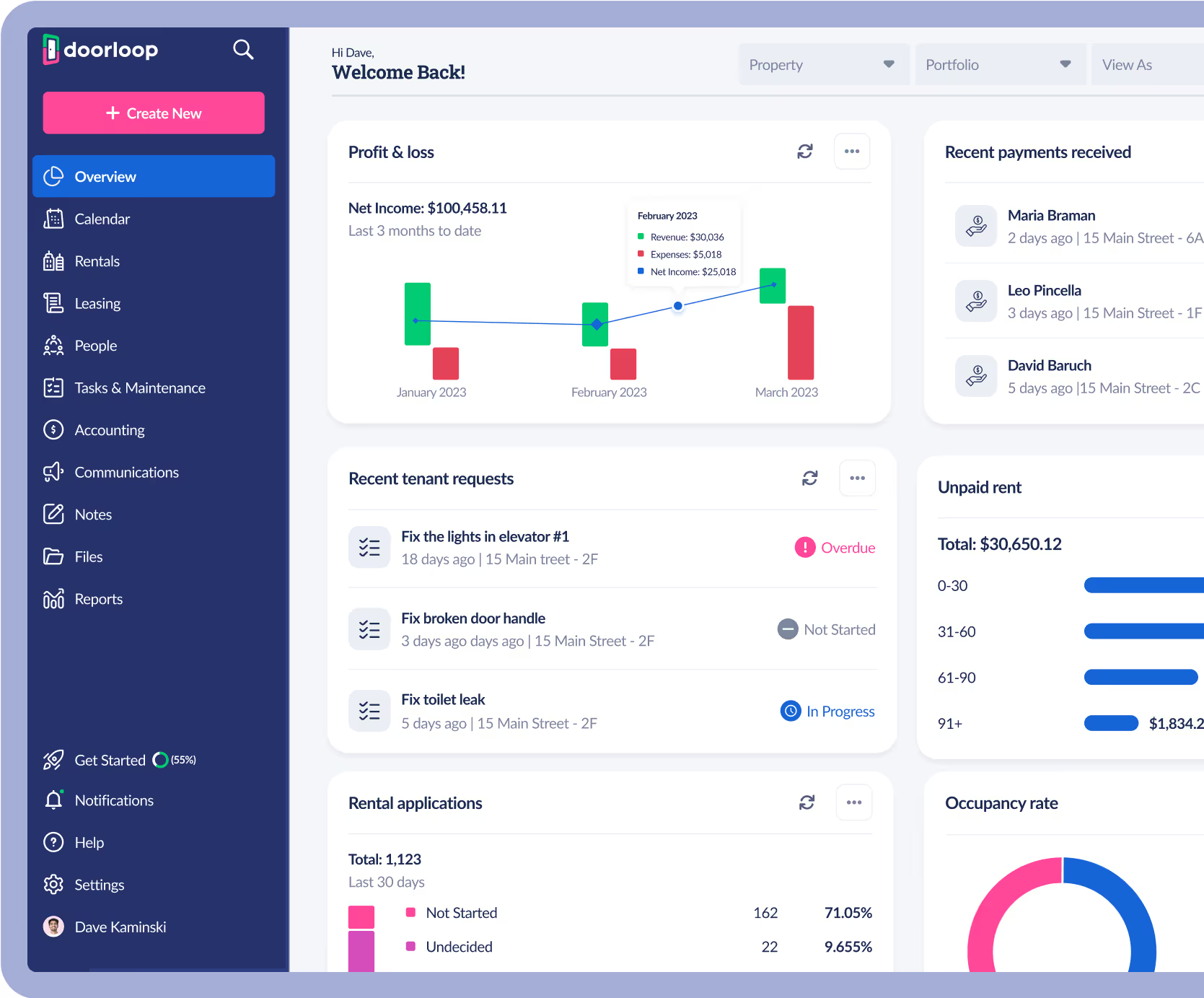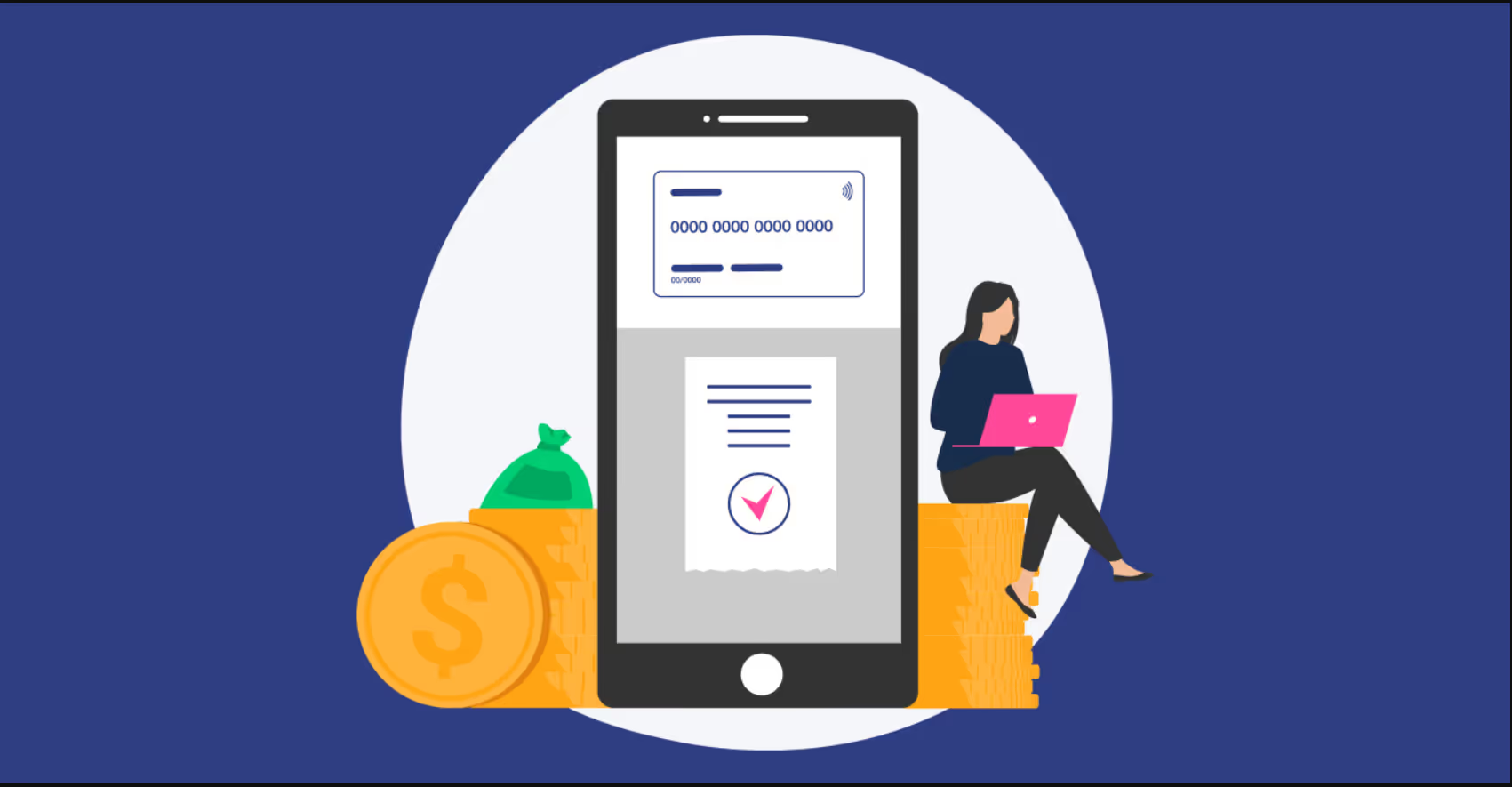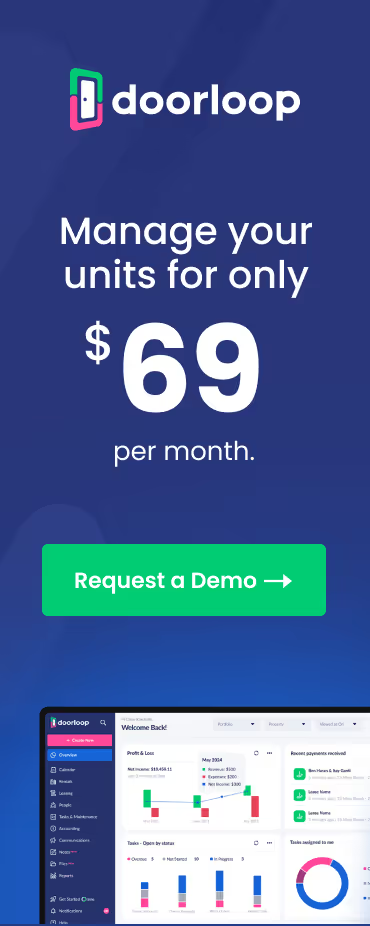The best way to collect rent as a landlord is by allowing renters to use direct deposit or bill pay services using their preferred mobile app, especially for younger tenants who are heavily dependent on their phones. However, for older tenants, the preferred and most trusted method is paying with a physical check.
Did you know property management software caters to both younger and older tenants by allowing diverse options? These online platforms handle direct deposit, eCheck, and even credit or debit card payments.
You don't even have to give tenants your bank account details. Tenants online pay through a Tenant Portal which keeps everyone's information protected and secured.
Now when it comes to collecting rent, systems should be in place that handle various things such as:
- Setting clear terms for paying rent
- Offering payment reminders with communication tools
- Providing multiple payment options
- Encouraging enrollment for recurring payments
- Implementing late payment policies
After all, rent is a contractual agreement that is legally binding. Therefore, it's important that all parties involved clearly understand the rental agreement.
Why your rent collection method matters
Choosing how to collect rent seems simple, but it’s one of the most important operational decisions you’ll make for your real estate business. It’s the engine that generates your rental income. The system you use directly impacts your cash flow, your efficiency, and even your relationship with your tenants.
Your rent collection process is the difference between a professional operation and a stressful side hustle. Here’s why it deserves your attention:
- It Defines Your Cash Flow. Inconsistent or slow methods lead to unpredictable cash flow. When you spend weeks waiting for checks to clear or chasing down late rent payments, it’s harder to pay your own mortgages, vendors, and maintenance crews on time.
- It Dictates Your Efficiency. How many hours do you spend sending reminders, driving to the bank, and manually entering payments into a spreadsheet? A clunky process drains your time—time you could be spending finding new properties or improving your existing ones.
- It Shapes the Tenant Experience. Today’s tenants expect clarity and convenience. A simple, professional payment process that also lets them submit work orders signals that you’re an organized landlord. An inconsistent one creates friction.
- It Determines Your Ability to Scale. The method that works for one or two units will hold you back at ten and is impossible at fifty. The right system is built for growth, allowing you to add more properties, including multifamily complexes, without adding more chaos.
Comparing the 6 Best Ways to Collect Rent
Choosing your rent collection method isn’t just about getting paid—it’s about setting the standard for your business. The right process saves you time, reduces financial risk, and improves the tenant experience. The wrong one creates manual work, accounting headaches, and unnecessary friction.
Before diving into the specific methods, here’s a high-level look at the two main categories.
A Quick Comparison: Online vs. Offline Rent Collection
1. Property management software
Pros:
- Built for Speed: Automates everything from reminders and late fees to tracking, encouraging on-time rent payments.
- Multiple Payment Options: Tenants can pay how they want—ACH transfers, credit card, or debit card—all through a secure online portal.
- Enhanced Security: Secure payment processing means you never have to share bank details.
- Full Financial Control: Payments are automatically logged in your accounting system. You can block partial payments during evictions and access real-time financial reports.
Cons:
- It's a professional tool: Unlike free consumer apps, dedicated software is an investment in your business.
Property management software allows tenants to pay rent online via credit card, debit card, or direct bank transfer. With property management software, you have the convenience of receiving online rent payments. This makes it easy to see all your rent payments and to keep track of your rent ledger. You can also set up automatic payment reminders and late payment notices.
Tenants also have access to an online portal–even from their smartphone–to view their balance, payment history, and more.
2. Direct deposit
Pros:
- Low Fees: Typically free or very low-cost for tenants to set up.
- Direct Payments: Funds are deposited directly into your bank account.
Cons:
- Major Security Risk: You have to give your bank account and routing numbers to every tenant, exposing your primary business account.
- No Control: You can’t block a partial payment from a tenant you’re evicting, which can reset the eviction process in some states.
- Messy Bookkeeping: Payments often arrive with vague descriptions, forcing you to manually match each deposit to the right tenant and property.
With this method, tenants transfer funds from their bank account to yours.
This is a simple but effective digital method that does not require you to physically visit the property. This method eliminates the hassle associated with in-person rent collection.
However, it is important to note this method may vary between banks, which could complicate the tracking and reporting of rent payments. Also, you may have to share your banking details with tenants.
3. Peer-to-Peer payment apps
Pros:
- Familiar for Tenants: Most people already have and know how to use these apps.
Cons:
- Built for Friends, Not Rentals: These platforms offer almost no protection for landlords. Tenants can dispute payments, and your account could be frozen for conducting business activity.
- No Automation: You still have to manually track who paid, remind those who haven't, and calculate late fees yourself.
- Strict Limits: Zelle limits transactions to $500/week for users whose banks don't offer it, making it unusable for most rent payments.
- Complicates Property Accounting: Creates a jumbled transaction history that’s separate from your primary accounting software like QuickBooks.
Money transfer platforms like PayPal, Zelle, Venmo are considerable options, particularly if tenants are looking for the ability to set up automated payments.
Money transfer services like PayPal, Zelle, and Venmo are popular payment platforms. But they have limits (and even added fees) on how much money they can send at one time and may not be the best choice for online rent collection.
Another potential drawback is that your tenant needs to have a PayPal account, or a Venmo account. Additionally, PayPal and Venmo don’t offer protection of any kind like a typical bank. If there’s an issue or dispute of any kind with the online payments, these platforms aren’t much help. Which means tenants can dispute their rent payment (even months later) which could cause you complications.
Further, if you are trying to evict a tenant, who hasn't paid rent in months, even a small payment can slow down the eviction process. You want an option to collect online rent payments that allows you to refuse payments from tenants you decided to evict.
4. Property manager
Pros:
- Saves You Time: The property manager handles all collections, reminders, and enforcement.
Cons:
- High Cost: Property managers typically charge 8-12% of the monthly rent, directly cutting into your profits.
- Loss of Control: You give up direct oversight of your properties and tenant relationships. Finding a manager who cares as much as you do can be a challenge, especially for complex commercial properties.
Hiring a property manager to manage a rental property is a great option to consider because it’s one of only a few that allows you to streamline this process. By streamlined, we mean the ability to pass off rent collection duties to an experienced professional who manages properties for a living.
Plus, you have flexibility in how you choose to use a property manager.
You could find one to handle all or most of your property management needs. Or, you could hire one that only handles rent collection, while you retain control over your marketing and leasing.
A few disadvantages is that you may give up some control of how your properties are being managed. Sometimes finding a reliable property manager who cares as much as you do for your properties isn't always easy to find either.
5. Physical checks via mail
Pros:
- Provides a Paper Trail: A cashed check is a clear record of payment.
- Familiar to Some Tenants: Certain tenants may be more comfortable with this method, especially if they have roommates who need to pay separately.
Cons:
- "Mailbox Anxiety": You're left waiting and wondering if the check will arrive on time, late, or not at all.
- Slows Down Cash Flow: You have to wait for the mail, drive to the bank, deposit the check, and wait again for it to clear.
- Risk of Fraud or Errors: Checks can bounce, be filled out incorrectly, or get lost in the mail, creating more work for you.
Collecting rent via physical checks is a traditional method that still holds favor among many older tenants due to its familiarity and the tangible record it provides. However, it comes with drawbacks such as potential delays and the absence of automatic payment options, which makes it less appealing compared to more modern, digital methods.
If you use this option, consider strategies to mitigate mail-related risks, such as providing multiple payment options or transitioning tenants towards electronic payments over time.
6. In-person collection
Pros:
- Property Check-in: Allows you to see the property and tenant regularly..
Cons:
- Drains Your Time: Driving between properties to collect payments is not a scalable use of your time.
- Adds Risk: Carrying large amounts of cash is a security risk. It also makes bookkeeping and financial tracking difficult and prone to errors.
- Inconvenient for Everyone: It requires you and your tenant to be in the same place at the same time, which can be difficult to coordinate.
If you have a small or affordable housing portfolio, this may be the method you currently use. The main benefit is in the ability to check on the condition of the property while you’re collecting rent.
Also, this is helpful for tenants who do not have the means to pay digitally or don't have a primary bank or credit union. Unfortunately, collecting rent in-person is both time-consuming and inconvenient.
However, if you’re having issues collecting rent from a particular tenant or, as we mentioned previously, if your portfolio type requires you to accept rent in cash, collecting rent in person may make sense.
What Is the Safest Method to Collect Rent?
The safest method to collect rent is a method that confirms funds are available in the tenant's bank account before payment is sent and received.
One of the safest and efficient methods to collect rent online is through property management software. A dedicated rent collection app is more effective and safer for managing residential units.
You can accept rent payments online with ease, which is especially useful in today’s digital-first age. The software automates the process, so payments are received on time and are trackable within your portal. Plus, funds are verified before they are sent to you.
Factors That Affect Collecting Rent Payments
While many properties have unique demands and every landlord being different, there are certain universal factors that affect rent collection.
1. Number of tenants + properties
If you have a single property with just a few tenants, many options are available for rent payment collection. However, if you have multiple properties, in various locations, with multiple tenants, collecting rent payments becomes a bit more involved.
2. Lease agreement
Clearly written leases with well-defined payment terms, penalties for late payments, and conditions for lease termination are essential for reducing rent collection issues.
3. Tenant employment stability
Tenants with stable, secure jobs are more likely to make regular rent payments. Industries that are volatile or subject to frequent layoffs might pose a higher risk of rent payment issues.
4. Tenant screening
Effective tenant screening, including reviewing rental applications and checking references, helps you select tenants who are likely to pay on time. This is a critical step before tenants move in.
5. Legal Regulations
Landlord-tenant laws, which vary by location, can impact how and when landlords can collect rents, charge fees, or evict non-paying tenants. Understanding these laws is crucial to managing rent collection.
Ultimately, choosing the right rent collection method depends on balancing convenience, security, and legal compliance. Offering multiple payment options by leveraging property management software accommodates the diverse needs of your tenants.
How to Create a Rent Collection Policy
A solid rent collection policy is the foundation of a healthy landlord-tenant relationship. It’s not about being strict; it’s about being clear. When the rules are written in the lease agreement, there’s no room for confusion or disputes down the line.
Think of your lease as the rulebook for your business. A well-defined policy protects your cash flow, saves you from awkward conversations, and ensures everyone is treated fairly and consistently.
Key Terms to Include in Your Lease Agreement
Your lease agreement is a legally binding contract. Make sure it explicitly details every aspect of the rent payment process.
- Full Rent Amount: State the exact dollar amount due each month ($XXXX.XX).
- Due Date: Specify the exact day rent is due (e.g., "on the 1st day of each calendar month").
- Accepted Payment Methods: Clearly list how tenants can pay. If you accept credit cards, specify who is responsible for any processing fees.
- Grace Period: If you offer a grace period, define it precisely (e.g., "A late fee will be assessed on any payment not received by 5:00 PM on the 5th of the month"). If you don't offer one, state that rent is late starting on the 2nd.
- Late Fee Policy: Clearly state the exact amount of the late fee and how it will be applied. This is so important, we’ll break it down further below.
- Returned Payment Fee: Include the fee you will charge for any returned or failed payment due to non-sufficient funds (NSF).
Setting and Enforcing Late Fees
Late fees aren't meant to be a source of profit; they are a tool to encourage on-time payments.
First, a crucial step: Always check your state and local laws. Many jurisdictions have strict limits on how much you can charge for a late fee. A quick search for "landlord-tenant laws [your state]" will usually provide the guidance you need.
Once you know your legal limits, you can structure your fee. The goal is consistency and fairness.
The best way to enforce late fees is to remove yourself from the equation. Manually tracking due dates, calculating fees, and sending reminders is time-consuming and prone to human error or inconsistent enforcement.
This is where choosing the right collection method makes all the difference. Property management software automatically:
- Sends rent reminders before the due date.
- Calculates and applies the correct late fee as soon as the grace period ends.
- Notifies the tenant of their updated balance.
Automating the process removes the emotion and eliminates awkward phone calls. It ensures your policy is enforced consistently and professionally for every tenant, every time. It’s the smart choice for anyone serious about running their properties like a business.
Discover how DoorLoop helps to collect rent payments swiftly and securely. Schedule a call!
Rent collection FAQ
What is the best way to set up the entire payment process for a new tenant, from the beginning?
First, properly screen tenants, then use a dedicated rent collection app to handle all funds, including the initial security deposits. These platforms are far more secure and efficient than manually collecting money orders and checks. The best apps automate the process and can often process bank transfers without a transaction fee.
What should I do if a tenant consistently pays rent late?
Communicate clearly about the importance of timely payments as outlined in the lease agreement. Consider enforcing late payment fees as specified in the lease, and discuss setting up auto-pay to avoid future issues.
Can I change a tenant’s payment method during the lease term?
Any changes to the payment method should be agreed upon by both parties and reflected in an amendment to the lease. Both parties must sign this amendment for it to be enforceable.
How do I handle rent collection if I own properties in different states?
It's important to familiarize yourself with the landlord-tenant laws in each state. Using property management software can help streamline rent collection across different regions and ensure compliance with varying state laws, which is especially crucial for portfolios that include HOA/community associations.
Is it safe to accept rent payments via peer-to-peer payment apps?
While peer-to-peer payment apps offer convenience, they can have limitations like transfer limits and less protection against disputes. Ensure that you understand the risks and benefits, and consider offering these as an option alongside more secure methods like direct bank transfers.
Does rent collection count as income?
Yes, rent collection counts as income for property owners and must be reported for tax purposes. However, related expenses can often be deducted to determine taxable income.
































.svg)
.svg)

